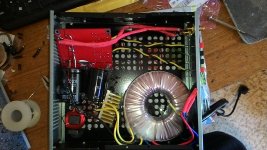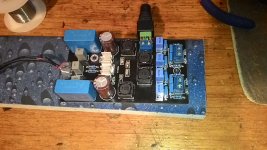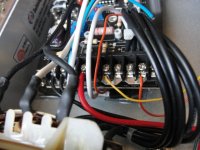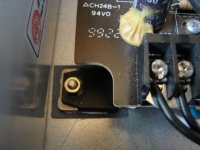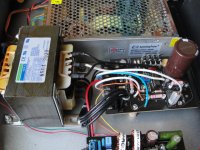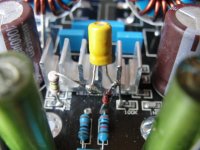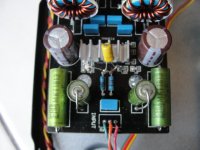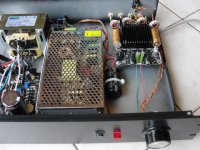For audio x7r ceramics need to be oversized regarding voltage, to have low distortion. Film caps usually don't have that kind of distortion that is avoided using 250V ceramic caps there. Ringh used TDK like wushuliu, but I think voltage is main interest when using ceramics. If you have 220n films laying around like wima or evox rifa, I tried both no distortion perceived.
Can you be more specific, what brand of caps; TDK, Vishay, or other? There are many X7R's.
Also, perhaps an image of your work, this one doesn't show how he soldered those on black/blue board, since TDK's are a bit different. Thanks
These are the ones I used: TDK part number FK20X7R2E224K. Digi-Key link. These are from the wiki.
These are through-hole, so installation should be obvious.
I used 100v ones found here:
0 22uF 100V 220nF X7R MLC Capacitor x10 FBE4A3 | eBay
However, I did a ton of mods to that particular board so I cannot make an unbiased comparison with un-modded bootstrap cap board.
I note the wiki says use 10x voltage or at a minimum 4x voltage for the bootstraps.
So, I assume the 100v are okay? Or did I blow this one?
0 22uF 100V 220nF X7R MLC Capacitor x10 FBE4A3 | eBay
However, I did a ton of mods to that particular board so I cannot make an unbiased comparison with un-modded bootstrap cap board.
I note the wiki says use 10x voltage or at a minimum 4x voltage for the bootstraps.
So, I assume the 100v are okay? Or did I blow this one?
Irribeo, I havent any equippment to measure capacitance on the old ones but the sound were night and day.. The new ones were 3 times larger which should keep them more stable. From this I guide I learned about the weakness of ceramics; Trevor Marshall - Class D Audio Amplifier Design - TDA7498 Output filters
In this tutorial he measured a capacitance of a ceramic bootstrap that were just up to the task voltage vise.. capacitance varied a lot and caused a 3% THD in a similar class D board as ours.
After trying out different caps on the power side I found distance to the chip were crusial to low noise. 7mm cap legs made unberable noise in my setup. That makes me belive that the legs on the film bootstrap caps adds noise because of increased ESR. Well thats my guess anyways. I will put X7R on the blueboard also.. I'll report back if there is the same improvement there! But for me the coarseness is just as bad on the blueboard (even on different speakers@4.1ohm).
I used these for bootstrapping,0,22uF; http://www.ebay.com/itm/271177868349?ssPageName=STRK:MEWNX:IT&_trksid=p3984.m1439.l2649
In this tutorial he measured a capacitance of a ceramic bootstrap that were just up to the task voltage vise.. capacitance varied a lot and caused a 3% THD in a similar class D board as ours.
After trying out different caps on the power side I found distance to the chip were crusial to low noise. 7mm cap legs made unberable noise in my setup. That makes me belive that the legs on the film bootstrap caps adds noise because of increased ESR. Well thats my guess anyways. I will put X7R on the blueboard also.. I'll report back if there is the same improvement there! But for me the coarseness is just as bad on the blueboard (even on different speakers@4.1ohm).
I used these for bootstrapping,0,22uF; http://www.ebay.com/itm/271177868349?ssPageName=STRK:MEWNX:IT&_trksid=p3984.m1439.l2649
Last edited:
These are the ones I used: TDK part number FK20X7R2E224K. Digi-Key link. These are from the wiki.
These are through-hole, so installation should be obvious.
Irribeo, I havent any equippment to measure capacitance on the old ones but the sound were night and day.. The new ones were 3 times larger which should keep them more stable. From this I guide I learned about the weakness of ceramics; Trevor Marshall - Class D Audio Amplifier Design - TDA7498 Output filters
In this tutorial he measured a capacitance of a ceramic bootstrap that were just up to the task voltage vise.. capacitance varied a lot and caused a 3% THD in a similar class D board as ours.
After trying out different caps on the power side I found distance to the chip were crusial to low noise. 7mm cap legs made unberable noise in my setup. That makes me belive that the legs on the film bootstrap caps adds noise because of increased ESR. Well thats my guess anyways. I will put X7R on the blueboard also.. I'll report back if there is the same improvement there! But for me the coarseness is just as bad on the blueboard (even on different speakers@4.1ohm).
I used these for bootstrapping,0,22uF; 10 x Murata Grm32dr72e224kw01l Capacitor 1210 X7R 250V 220nF | eBay
I just soldered on the same smd bootstraps to the blueboard also and the same improvement there! Now the board sounds sweet! The board has had no burn in, just played about 30min total.. The only thing that could be better is perhaps the bass compared to the highly modded red board. The X7R smd's I use is from the link above and are quite large and easy to solder. I know that the film caps I took out should work perfect but the smd's sound a lot cleaner to me. Way less sharp sss (sibliance) and strings are way better.
With using smaller value, lower ESR caps, you will find a significant improvement. Initially, I had good results with improved bass and dynamic response using larger caps, but found the midrange to be grainy and strained. I switched from 1,500uF/25V Panasonic FM to 470uF/35V Panasonic FM and the results were very positive. Then I read wushuliu's post about using Panasonic hybrid Aluminum electrolytic-organic polymer caps. I read some Panasonic white papers and data sheets and decided to try the 330uF/25V Panasonic SEPF OSCON caps. In all three of my TPA31xx amps, switching to these OSCON caps has been very positive. The bass is better defined, the dynamic response is quick. Better yet, the midrange and highs are more fluid and relaxed. I mentioned before that using these low ESR (~ 14-16mohm) caps and X7R ceramic caps on the bootstrap positions per the Texas Instruments TPA data sheets (and Saturnus) are probably the best modifications you can make to these amps.
I recently switch to the OSCON caps for my new SMSL SA-36A Pro TPA3118D2 amp, and again, the amp sounds much better.
View attachment 422860
At Rhing's suggestion I ordered some 330uF OSCON's for a Danzz black/blue board also just ordered. I think I have the correct X7R bootstrap caps on hand already from a previous build. I also ordered a 3.3uF 250v poly film cap for the inputs to get the true 20 Hz bass extension.
Looking forward to it powering my 98dB sensitive bass horn.
Thank you! Don't know what's happened to my previous replay though?

Thanks to matt_garman as well for his feedback 🙂
...I also ordered a 3.3uF 250v poly film cap for the inputs to get the true 20 Hz bass extension...
At the risk of opening a which-capacitor-is-best can of worms...
For these high-voltage signal coupling / DC de-coupling caps, the Wiki lists several that members have used in their builds.
My better judgment says the answer is probably "no", but is there any semblance of a consensus on what might be considered a good "high value" cap for this board? That is, the board itself is only $20, so it seems rather silly to spend 2x that or more on a single, esoteric cap.
I.e., is there a readily-available, fairly cheap cap line that offers a good price/performance ratio?
I stumbled across this capacitor comparison, which is interesting, but many of those caps are expensive and/or hard-to-find.
I am getting the cheapest ($0.94 ea) polyester film cap with the 3.3uF value. I need the larger value to ensure that there is no attenuation of low freq signals for the 26dB gain case. I think the stock 1uF cap starts rolling off at 40 Hz. You could probably roll your own cap with gold foil and 17th century parchment soaked in beluga oil 🙂. It may sound better but cost $500 for a cap.
I have heard good things about several boutique caps in the $40 range but that is still too much for a $20 amp.
I have heard good things about several boutique caps in the $40 range but that is still too much for a $20 amp.
At Rhing's suggestion I ordered some 330uF OSCON's for a Danzz black/blue board also just ordered. I think I have the correct X7R bootstrap caps on hand already from a previous build. I also ordered a 3.3uF 250v poly film cap for the inputs to get the true 20 Hz bass extension.
Looking forward to it powering my 98dB sensitive bass horn.
Any reason why MLCC ceramic cap will work better as bootstrap cap than film cap?
I am no expert but my guess is that the bootstrap cap is on the active output side so it needs to be small and as close to the IC pins as possible to avoid being a radiator antenna from the RF generated in the switching. If you did not care about radiated emission, probably fine to use film caps there but they can't get as close to the pins or ground plane.
I am no expert but my guess is that the bootstrap cap is on the active output side so it needs to be small and as close to the IC pins as possible to avoid being a radiator antenna from the RF generated in the switching. If you did not care about radiated emission, probably fine to use film caps there but they can't get as close to the pins or ground plane.
Thanks for the explanation. I may also want to try this cap too.
PANASONIC - CAP, FILM, PPS, 220NF, 50V, SMD
From this I guide I learned about the weakness of ceramics; Trevor Marshall - Class D Audio Amplifier Design - TDA7498 Output filters
In this tutorial he measured a capacitance of a ceramic bootstrap that were just up to the task voltage vise.. capacitance varied a lot and caused a 3% THD in a similar class D board as ours.
I had a look at that link - I saw he changed from a 1uF ceramic output capacitor and reduced his distortion 10-fold, but he's talking there about ST's TDA7498 which doesn't have any external bootstrap caps.
It is really doubtful what's the point in spending a fortune for the little bargain board and get (perhaps) a little better sound, although many claim it is worthy. Well, from the DIY hobby perspective certainly is. 🙂 But,... hmmAt the risk of opening a which-capacitor-is-best can of worms...
For these high-voltage signal coupling / DC de-coupling caps, the Wiki lists several that members have used in their builds.
My better judgment says the answer is probably "no", but is there any semblance of a consensus on what might be considered a good "high value" cap for this board? That is, the board itself is only $20, so it seems rather silly to spend 2x that or more on a single, esoteric cap.
I.e., is there a readily-available, fairly cheap cap line that offers a good price/performance ratio?
I stumbled across this capacitor comparison, which is interesting, but many of those caps are expensive and/or hard-to-find.
I did recently modified my Music Angel tube preamplifier that did cost me some $350 (TAX/postage incl.) and it was somehow reasonable to spend a 'few' more bucks for an upgrade, but not earlier than two years later.
For that I used that same link of capacitors comparison and guide, and found this - Mundorf MCap EVO Aluminium, two only as De-coupling caps. Yes, these two cost about $20 (shipp.incl.), comparing price-performance ratio to the original price of device is undoubtedly excellent.
I will see, once I get my black board and try it as is. Perhaps will do some mode for fun and go for a bargain yet excellent old Russian PEPT's 2uf 250V (2 for $6) or any of these affordable polypropylene's, like Siemens, Phillips, or even some of these new Chinese that came out lately like JieDeng 250V 2.2uF Metallized Polypropylene Non-Polarized Capacitor, that two cost almost nothing - $3,99 (shipp.inc.) 🙂 Anyhow, poly-yes, but certainly NOT polyesters!
Linear PS installed...
I finally put the linear PS inside the chassis. The PS is based on classic uA723 chip driving two pass transistors. The linear PS had to be disassembled and the two TO-3 2n3055 was replaced by other NPN transistors (TO-220 type) which mounted onto the bottom chassis under the PS board for heat dissipation purpose. The PS was originally at 24V but I do agreed that the amp sounds better at a lower supply voltage so I lowered it to give 19V. This will also reduce the heating-up of the output coils a little bit as well.
Input caps are ERO MKT 1813 2.2uF type. I like these caps, they do sound better than stock caps. I have concluded that the power-off pop is due to the difference in cap values at the + and - inputs. At first, I only changed the two caps on the + L/R inputs to 2.2uF, leaving the two on the - inputs to be 1uF. Then I had power-off pops. I believe it is due to the different discharging rate when powering off since the input is at 3V dc per datasheet. After changing the two 1uF caps to 2.2uF EROs at the - inputs, no more power off pop.
I also implement the power on pop circuit suggested by member Giancarlo69. (the yellow cap, 150kR and a diode).
You can see the right side of the dual amp is the original Sure TK-2050 with a SMPS modded with the same output coils and input caps.
Next will be the bootstrap caps and power tank caps. Why don't we just get the bare boards ? We are changing mostly everything on the blue board anyway.......
I finally put the linear PS inside the chassis. The PS is based on classic uA723 chip driving two pass transistors. The linear PS had to be disassembled and the two TO-3 2n3055 was replaced by other NPN transistors (TO-220 type) which mounted onto the bottom chassis under the PS board for heat dissipation purpose. The PS was originally at 24V but I do agreed that the amp sounds better at a lower supply voltage so I lowered it to give 19V. This will also reduce the heating-up of the output coils a little bit as well.
Input caps are ERO MKT 1813 2.2uF type. I like these caps, they do sound better than stock caps. I have concluded that the power-off pop is due to the difference in cap values at the + and - inputs. At first, I only changed the two caps on the + L/R inputs to 2.2uF, leaving the two on the - inputs to be 1uF. Then I had power-off pops. I believe it is due to the different discharging rate when powering off since the input is at 3V dc per datasheet. After changing the two 1uF caps to 2.2uF EROs at the - inputs, no more power off pop.
I also implement the power on pop circuit suggested by member Giancarlo69. (the yellow cap, 150kR and a diode).
You can see the right side of the dual amp is the original Sure TK-2050 with a SMPS modded with the same output coils and input caps.
Next will be the bootstrap caps and power tank caps. Why don't we just get the bare boards ? We are changing mostly everything on the blue board anyway.......
Attachments
AC439,
Great work there! Your Blue/Black board looks like it is quite hot-rodded out now. Just need some OSCON power caps! Great looking PS and case work there.
Great work there! Your Blue/Black board looks like it is quite hot-rodded out now. Just need some OSCON power caps! Great looking PS and case work there.
I finally put the linear PS inside the chassis. The PS is based on classic uA723 chip driving two pass transistors. The linear PS had to be disassembled and the two TO-3 2n3055 was replaced by other NPN transistors (TO-220 type) which mounted onto the bottom chassis under the PS board for heat dissipation purpose. The PS was originally at 24V but I do agreed that the amp sounds better at a lower supply voltage so I lowered it to give 19V. This will also reduce the heating-up of the output coils a little bit as well.
Input caps are ERO MKT 1813 2.2uF type. I like these caps, they do sound better than stock caps. I have concluded that the power-off pop is due to the difference in cap values at the + and - inputs. At first, I only changed the two caps on the + L/R inputs to 2.2uF, leaving the two on the - inputs to be 1uF. Then I had power-off pops. I believe it is due to the different discharging rate when powering off since the input is at 3V dc per datasheet. After changing the two 1uF caps to 2.2uF EROs at the - inputs, no more power off pop.
I also implement the power on pop circuit suggested by member Giancarlo69. (the yellow cap, 150kR and a diode).
You can see the right side of the dual amp is the original Sure TK-2050 with a SMPS modded with the same output coils and input caps.
Next will be the bootstrap caps and power tank caps. Why don't we just get the bare boards ? We are changing mostly everything on the blue board anyway.......
Nice work AC439. How does your amp sound? Better than stock?
I tried the 3.3uF/160V Wima MKP10 in my Yuan Jing blue amp, but found a faint high pitched noise. I suspect that the wires connecting the cap leads to the PCB were picking up some switching noise.
I've since switched back to the stock 1uF/250V Epcos MKP caps and found the bass to be adequate for my listening. The 3.3uF Wima's did go lower, but not as significantly as one would expect, and the noise was annoying enough to go back.
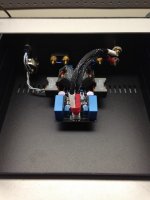
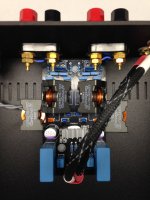
If I try rolling other input caps, I might try the 2.2uF NOS ERO MKT1822 metallized Polyester film caps that I have in my parts bin. They have the 22.5mm lead spacing for a perfect fit on the "+" input thru-holes. They take a while to smooth out as they are obnoxiously bright when first installed.
Funny thing is there are 3.3uF/250V Epcos MKT film caps in my SMSL SA-36A Pro TPA3118 amp's inputs, and they sound great. As good as the SMSL amp is, it still has that turn-off thump that is probably more annoying since my Klipsch Forte II speakers are 98db sensitive.
- Home
- Amplifiers
- Class D
- TPA3116D2 Amp
